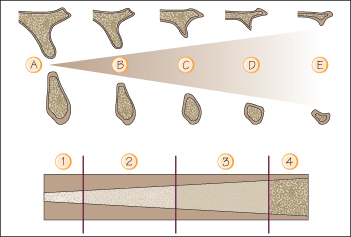5
The basics: bone shape and quality
The volume, shape, and quality of the bone are important parameters in establishing the treatment plan. They strongly influence the choice of surgical procedure and implant dimensions.
The bone volume determines the available bone, i.e. the bone dimension that can be used for dental implant placement. The quality of the bone, i.e. the density, strength, and elasticity, may determine the ability of the bone to support the stress induced by the prosthetic restoration.
Bone Shape
Bone volume atrophy depends on numerous factors such as tooth loss, trauma, infection, periodontitis, and tooth extraction procedures. After tooth extraction, the alveolar bone resorption is more important at the facial aspect than at the palatal/lingual cortical plates, irrespective of the alveolar preservation techniques. The alveolar bone loss is almost 10 times greater 3 months postoperatively than in the years following tooth extraction. The resorption is higher at the posterior maxilla than in other areas of the jaws.
Several classifications have been proposed. The classification of Lekholm and Zarb (1985) is based on the residual jaw morphology and deals with the insertion of dental implants. They described five levels of jaw resorption in edentulous patients, ranging from minimal to severe osseous atrophy (Fig. 5.1).
Figure 5.1 Classification of the host bone. (A-E) Bone shape. (Group 1 to Group 4) Bone quality: 1. cortical bone; 2. dense cortico-cancellous bone; 3. sparse cortico-cancellous bone; 4. thin cortical and very sparse medullar bone.

Bone Quality
The quality or density/>
Stay updated, free dental videos. Join our Telegram channel

VIDEdental - Online dental courses


